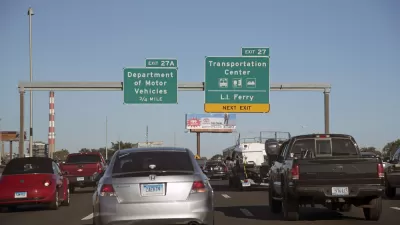Connecticut Governor Dan Malloy sees potential benefits in economic development and congestion reduction in a pair of highway widening proposals in his state.
Heather Brandon reports that Connecticut Governor Dan Malloy has hit the road to stump for a plan to add lanes to part of I-84 and the length of I-95 in the state.
A soundbite from Gov. Malloy quoted in full in the article claims a dramatic multiplier effect from the highway widening projects: "Adding travel lanes in both directions on I-95 from Greenwich to North Stonington, and on I-84 between the areas of Waterbury and Danbury, would provide economic benefits to our state of nearly 40 billion dollars -- about four times the cost of widening those two highways," Gov. Malloy said. Unmentioned are the likely effects of ongoing maintenance costs or long-term externalities like pollution on the size of that multiplier.
The article begins with an interesting take on induced demand (in this case defined as "a term economists use to describe how a bigger supply of a good thing can make people want more of it"), which says that Gov. Malloy is "banking" on induced demand rather than neglecting to consider the long-term effects of induced demand. Gov. Malloy himself implies the latter: his second talking point in favor of widening the highways is as a congestion reduction measure. Eventually, Brandon quotes Charles Marohn, founder of Strong Towns, to counter that argument, and explain the possible futility of the project as a congestion reduction measure.
In an earlier article, Joseph Cutrufo described a double standard afforded highway widening projects by the media.
FULL STORY: Gov. Malloy: Widening Highways Is Good for the State Economy

Planetizen Federal Action Tracker
A weekly monitor of how Trump’s orders and actions are impacting planners and planning in America.

Congressman Proposes Bill to Rename DC Metro “Trump Train”
The Make Autorail Great Again Act would withhold federal funding to the system until the Washington Metropolitan Area Transit Authority (WMATA), rebrands as the Washington Metropolitan Authority for Greater Access (WMAGA).

The Simple Legislative Tool Transforming Vacant Downtowns
In California, Michigan and Georgia, an easy win is bringing dollars — and delight — back to city centers.

The States Losing Rural Delivery Rooms at an Alarming Pace
In some states, as few as 9% of rural hospitals still deliver babies. As a result, rising pre-term births, no adequate pre-term care and "harrowing" close calls are a growing reality.

The Small South Asian Republic Going all in on EVs
Thanks to one simple policy change less than five years ago, 65% of new cars in this Himalayan country are now electric.

DC Backpedals on Bike Lane Protection, Swaps Barriers for Paint
Citing aesthetic concerns, the city is removing the concrete barriers and flexposts that once separated Arizona Avenue cyclists from motor vehicles.
Urban Design for Planners 1: Software Tools
This six-course series explores essential urban design concepts using open source software and equips planners with the tools they need to participate fully in the urban design process.
Planning for Universal Design
Learn the tools for implementing Universal Design in planning regulations.
Smith Gee Studio
City of Charlotte
City of Camden Redevelopment Agency
City of Astoria
Transportation Research & Education Center (TREC) at Portland State University
US High Speed Rail Association
City of Camden Redevelopment Agency
Municipality of Princeton (NJ)



























